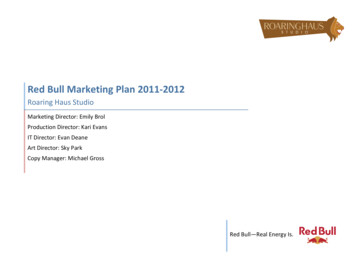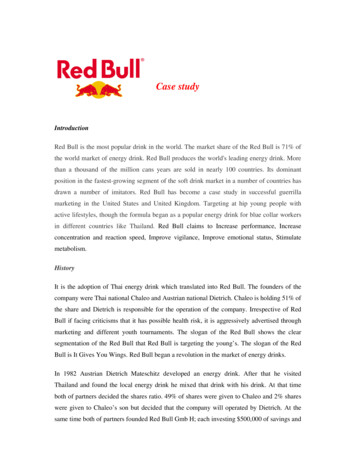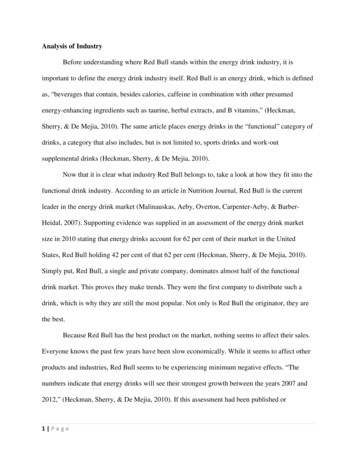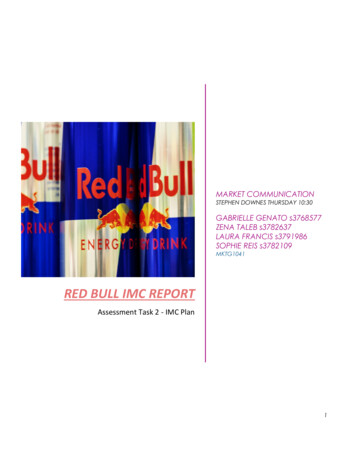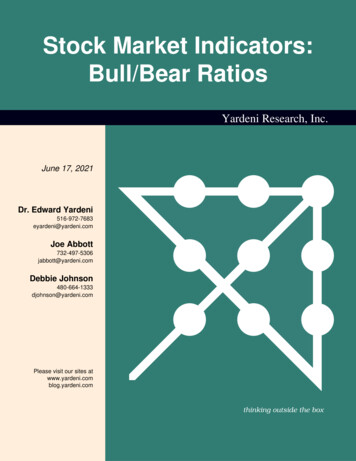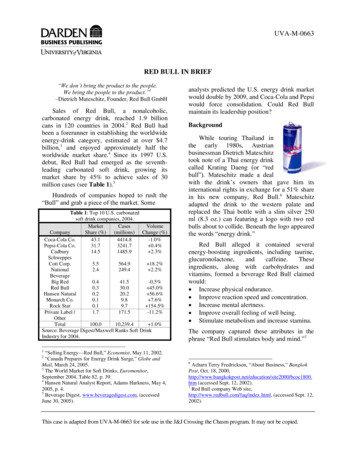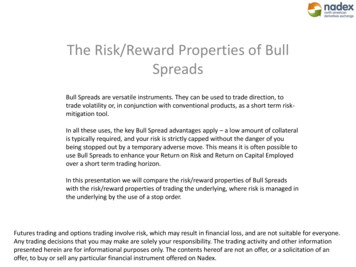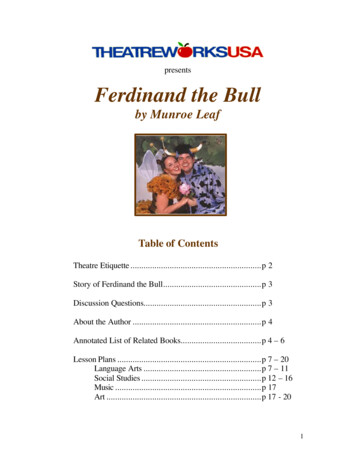
Transcription
presentsFerdinand the Bullby Munroe LeafTable of ContentsTheatre Etiquette .p 2Story of Ferdinand the Bull.p 3Discussion Questions.p 3About the Author .p 4Annotated List of Related Books.p 4 – 6Lesson Plans .p 7 – 20Language Arts .p 7 – 11Social Studies .p 12 – 16Music .p 17Art .p 17 - 201
BULL-E-TON! BULL-E-TON! BULL-E-TON!(THEATER ETIQUETTE)Just a reminder to be on your best behavior while you’re at this theatre performance.Here are a couple of helpful hints to make your theater visit successful andsatisfying for everyone.1.Watching a theatre production is different from watching television or going tothe movies. In theaters, the actors can hear you almost as well as you hear them.So be very quiet during their performance. Don’t worry! It is ok to laugh, clap,and respond to the performers when it is appropriate.2.Use the restroom before the performa nce so you don’t miss anything or disturbanyone. If necessary, students may go in small groups with teacher's permission.Younger students must be supervised.3.While you can usually have popcorn at a movie, the theater is a special place.Food, gum, candy, and drinks are not allowed, as well as, radios, cameras,tape/video recorders or cell phones/pagers.4.Following the performance, your school will be dismissed by a member of theCSB/SJU Fine Arts Programming staff.These rules will make it easier for everyone in the audience toexperience the MAGIC of live theatre!Enjoy the show!!!2
The Story of Ferdinand, the BullAuthor: Munroe LeafIllustrator: Robert LawsonPublisher: NY: Puffin BooksDate: 1936/1964 printingSetting : the Spanish countrysideCharacters : Ferdinand, the Bull, his mother, and the men who come in search of bullsfor bullfightingPlot: For a bull, Ferdinand has an unusual disposition. He prefers peacefully admiringflowers to bucking aggressively like the other young bulls. One day, a group of mencome looking for aggressive young bulls for the bullfight. Coincidentally, Ferdinand isstung by a bee. His lively reaction to the bee sting is perceived by the men as anindication that Ferdinand will be effective in the bullfighting ring. When he is broughtto the arena, however, Ferdinand is true to himself. He calmly sits and admires theflowers worn by the women in the audience. All ends well when Ferdinand is returnedto the cork tree and the flowers in his idyllic pasture.Theme : Being yourself works out for the best.DISCUSSION QUESTIONSAfter reading the book and watching the performance, some questionsto think about afterwards.1. What was it that attracted Ferdinand to sitting under the cork tree?2. Why did Ferdinand’s mother want him to play with the other bulls?3. Why do you think the men selected Ferdinand for the bullfight?4. Do you think Ferdinand would have fought in the bullring if he had not beendistracted by the flowers the women wore? Why?5. Why do you think the illustrator drew all the pictures in the book in pen and ink?6. How did the book's illustrator show you that Ferdinand’s mother cared abouthim? How did the author do the same thing?7. How do you think Ferdinand’s mother changed in this story? What do you thinkcaused the changes?8. In one of the book's illustrations, Lawson depicts a cork tree adorned withclusters of corks. Why did the illustrator make that choice?3
Other Books by Munroe LeafWee Gillis. 1938.Robert Francis Weatherbee. 1935.Ferdinandus Taurus. 1962.Aesop’s Fables. 1941.Who Cares? I Do. 1971.Other Books written and/or illustrated by Robert LawsonWee Gillis. By Munro Leaf. 1938.Adam of the Road. By Elizabeth J. Gray. 1942.Aesop’s Fables. By Munro Leaf. 1941.Ben and Me. 1939.Four and Twenty Blackbirds. 1937.The Tough Winter. 1954.The Hurdy-gurdy Man. 1979.Mr. Revere [Paul] and I. 1953.Rabbit Hill. 1944.Robbut, A Tale of Tails. 1948.They Were Strong and Good. 1940.Annotated list of related booksPRIMARY LEVELFlanagan, Alice K. The Zunis. History and Culture of Mexico. Wonderful illustrationsthat include authentic photographs and drawings.Ets, Marie Hall and Labastida, Aurora. Nine Days to Christmas .Different Christmas traditions that Hispanic cultures partake in, including a Christmasposada party.Fine, Anne. (Illustrator Penny Dale). The Jamie and Angus Stories. Six tales foremergent readers. About the adventures of Jamie, a resourceful preschooler, and Angus,his stuffed Highland bull.Laden, Nina. When Pigasso Met Mootisse. Loud, bright pictures about two rival artists,a pig and a bull. The parody about Picasso and Matisse will most likely be missed byyoung readers.Schnetzler, Pattie L. (Illustrator Rick Sealock). Widdermaker.4
“Widdermaker is a side splitting, knee slapping ride through the great geographicwonders of the west as Cowpoke Pete pursues the notorious Widdermaker, the meanestorneriest bull you can imagine.” (from Amazon.com, Reviewer, Peggy Tibbetts, Silt,CO).Lindgren, Astrid. (Illustrator Marit Tornqvist). The Day Adam Got Mad. Adam, theprize bull, becomes enraged and breaks out of the barn. The neighbor boy, Karl, calmshim down. Illustrated in lovely watercolors.Johnston, Tony. (Illustrator R. W. Alley). The Bull and the Fire Truck. Bernardo thebull learns to attack all things red after he is transported to his new home in a red truck.This lively story is resolved when everything red is painted another color.Arrington, Frances. (Illustrator Aileen Arrington). Stella’s Bull. Though she has neverseen him, Mary Wilson is terrified of Stella’s Bull. A depression-era story softlyillustrated in colored pencil.Braun, Lutz. (Illustrator Stephen Moore). Faster than the Bull.“Thirteen- year-old Gonzalo Sanchez pursues his dream to become the winner of thetraditional Running of the Bulls in Spain” (Horn Book, 1993).Speed, Toby. (Illustrator Barry Root). Two Cool Cows. Another cow-jumped-over-themoon-story.Paterson, Katherine. (Illustrator Jane C. Brown). The Smallest Cow in the World. This isa story about a farm boy named Marvin who is really attached to a cow. When his familymoves away from the farm, Marvin imagines that Rosie, the cow, is still with him.Chase, Edith Newlin. New Baby Calf. Buttercup the cow has a new baby calf. With lotsof love and mother’s milk, the calf grows up to be happy and healthy in a barn with otheranimals.Miranda, Anne. Alphabet Fiesta: An English/Spanish Alphabet Story. Zelda Debra’sfriends plan to bring really special gifts for her surprise birthday party. The illustrationswere done by grade-school children living in Spain.Vicente, Luis San Vicente. Festival of the Bones/El Festival de Las Calaveras. A bookcelebrating a Mexican festival called Day of the Dead. A respected artist, Vicenteaccentuates the holiday’s merriment with skeletons who dance in top hats and ridebicycles amid a surreal world.INTERMEDIATE LEVELRivas, Maite Suarez. Latino Read-Aloud Stories. This is a unique collection thatintroduces children to the exciting, heroic, and imaginative traditions of Latino culture.5
Loya, Olga and Lizardi-Rivera, Carmen. Momentos Magicos/Magic Moments. Writtenin both English and Spanish. Includes 15 traditional tales from Latin America arrangedin four sections: Scary Stories, Trickster Tales, Strong Women, and Myths.Huck, Charlotte. (Illustrator Anita Lobel). The Black Bull of Norroway: A Scottish Tale.A Scottish version of “Beauty and the Beast” with the beast as a bull.Smith, Linda (Illustrator Kathryn Brown). When Moon Fell Down. A co-jumped-overthe-moon story in poetry form with creative dream- land ideas. Moon visits earth to playwith cow.Martin, Bill and Archambault, John. (Illustrator Ted Rand). White Dynamite and CurlyKidd. A bronco-busting, rhyming- good-ride.Cronin, Doreen. (Illustrator Betsy Lewin). Click, Clack, Moo: Cows that Type.Farmer Brown’s cows use an old typewriter to write him notes demanding better workingconditions. Later they go on strike and then support the striking hens. A duck is themediator.Johnson, Paul Brett. The Cow Who Wouldn’t Come Down. Farmer Rosemary mustconvince her flying cow to come down to earth so she can be milked. But how can shelure Rosemary down when Rosemary is having so much fun?Wojciechowska, Maia. Shadow of a Bull. At age 12, Manolo must decide whether tosuccumb to community pressure to become a bullfighter like his legendary father. ButManolo wants to pursue his own dream of becoming a doctor.Barchas, Sarah (Ed.) (Illustrator Elizabeth Gething). The Giant & the Rabbit: SixBilingual Folktales from Hispanic Culture. Six folktales reflecting the richness anddiversity of Hispanic culture are shared bilingually by storyteller Sarah Barchas. Thepackage includes a guidebook that can be used in classrooms or with ESL students.Ryan, Pam Munoz. Esperanza Rising. Esperanza and her mother are forced to leavetheir life of wealth and privilege in Mexico to go work in the labor camps of SouthernCalifornia, where they must adapt to the harsh circumstances facing Mexican farmworkers on the eve of the Great Depression.6
LESSON PLANSLanguage ArtsA Li- BULL -ry of PoemsPrimary Level:Bulls by Katie Krause & Lauren Chupita(A variant of “Giraffes” by Mary Ann Hoberman)**This poem works well as a choral reading with assigned parts. Childrencould also be asked to think of additional rhyming couplets to add to thepoem.Bulls.I like them.Ask me why.Because they like to run and playBecause they gambol all the dayBecause they munch on grass and flowersBecause they entertain for hours.Because their bodies are so big and wide,Because they run but just can’t hide.Because they like to be so rowdy,Because they play when days are cloudy.Because they can be pretty loud,Because el toro is so proud.Because. That’s whyI like bulls.7
“The Bulls Go running 2 by 2” lyrics by Kristen Warner(Sung to the tune of “The Ants go Marching”)The bulls go running two by two,Hoorah, hoorahThe bulls go running two by two,Hoorah, hoorah,The bulls go running two by two, The baby one stopped to say, “atchoo!” And they all went running down,To the field,To feastOn the grain.Verse #2:Verse #3:Verse #4:Verse #5:Verse #6:Verse #7:“ the mama ambled down to the zoo ”“ the sister’s horns just grew and grew ”“ the brother’s hoof was stuck in glue ”“ the daddy stopped to moo and moo ”“ the grandpa hugged a kangaroo ”“ the grandma stopped—she had the flu ”œ œ œ œ “Five Little Bulls” by Kate Muchlinski(patterned after “Five Little Monkeys Jumping on the Bed”)**This song can be used as an introduction to the story of Ferdinand, theBull. It can also be used as an opportunity to practice simple subtraction.Five little bulls, bumping heads.Bumped too hard, one bruised red.Four little bulls, bumping heads.Bumped too hard, one flew in the shed.Three little bulls, bumping heads.Bumped too hard, one sent to bed.Two little bulls, bumping heads.Bumped too hard, off one fled.One little bull, couldn’t bump heads.Got so sad, moped by the hedge.8
Intermediate Level:Ferdinand and the Matador A poem in two voices by Tina Lynch and Chris Edwards(It is written in the style of Paul Fleischmann’s Joyful Noise poems.) **This poem workseffectively as a two-part choral reading. Half of the class might read Ferdinand’s part onthe left hand side while the other half might simultaneously read the matador’s part.FerdinandMatadorBeing a bullis a joy.Being a matadoris a thrill.And I’ll tell you why.I can spend countless hours peering at the sky.And I’ll tell you why.Because I strike fear in a bull’s eye.I can lounge under a tree,take time just for me.I am the greatest you see!with me they all agree.Hay de mi! I just sat on a bee!This bull that I seeNow why does the matador look like that atme?!Will win me a trophy!œ œ œ œ A Bull-erick a limerick by Jill Lorenzini(A variant on Arnold Lobel’s Pigericks)There once was a bull named FerdWho thought he resembled a bird.He would tweet day and nightAnd try to take flight,Lacking wings, he looked very absurd.œ œ œ œ Ferdinand an original poem by Jill LorenziniHorns like an overgrown cow,Much larger, by far, than the sow,With a great ring in his nose,He sniffs at a rose,This beast before whom the matador bows.What creature is this?You’ve got only one guess – don’t miss!Not a bird, a fish, or a horse Why, it’s Ferdinand, the Bull, of course!9
An Untitled Poem By Jose Zorilla in English translation by Thomas Walsh**Suggestions for use: Focus on the descriptive language and/or the brutality ofthe bull fight and it’s almost incomprehensible entertainment value. Circle thedescriptive words that evoke the brutality of the bull fight. Discuss the poet’s choice ofwords and its effect. Do the descriptive words accurately depict the brutal and violentnature of the bull fight?Pawing the earth, and snorting in his rageThe Bull is tossing up the torrid sand;The while the horseman’s eye serene and blandSeeks out a point for his red lance to gauge.Steadied to take the charge, the fight to wage,The picador holds his impatient stand;His face, for all it’s blackness, whiter fannedTo anger as the bull obstructs the stage.He hesitates; the Spaniard jeers at him;He shakes his horned front, he tears the earth,Heaving great breaths and straining every limb;The taunter urges him to prove his worth;Sudden he charges, fails, and bellows grim,His shoulder bleeding, the great crowd in mirth!œ œ œ œ Word play/invention using bull in initial, medial, or final word position**Students can be invited to write jokes and riddles.Examples: “What do you call a bull that can’t be stopped?”Answer: Unstopp-a-BULL“What’s a bull’s favorite kind of meat?”Answer: BULL-ogna**Students can be asked to create a “BULL-e-TON BOARD” of words orexpressions with “BULL” in them (in either the initial, medial or final position).Students might substitute a picture of a bull’s head for the “bull” syllable in each word.As an alternative, they might develop a “BULL-ictionary” using the same types ofwords. They might define their dictionary entries and/or illustrate them. Examples:-ish on Americae-BULL- ientBULL- aBULL- izardtrou-BULLBULL- istic10
**BULL Bingo: Using the terms on the BULL-e-TON board or from the BULLictionary (above), students can play BULL Bingo. Each student is given a BULL Bingocard. Using words from the BULL-e-TON Board or the BULL- ictionary, students recorda word of their choice in each of the card spaces with the exception of the center freespace. From this point, the game is played like traditional bingo. Bingo can also beplayed with the Spanish Vocabulary listed below.*Spanish Language nmy name is .hellohow are you?good, thanksand you?torotorerocorrida de orrerpelearEspañaMe llamo es hola¿Como estas?bien, gracias¿Y tú?11
SOCIAL STUDIESSELF-CONCEPT:**Self and Other Perceptions in a Venn DiagramOne of the critical aspects of this story is that Ferdinand does not capitulate to theerroneous perceptions that the men have of him. He holds firm to his identity. His selfperceptions are unwavering. In order to address this aspectof the story, have the students work in small groups toidentify how Ferdinand saw himself. Then repeat theprocess (or have ½ of the class work on each part) toidentify how the men viewed Ferdinand. Have the studentsdevelop a Venn diagram that illustrates the contrast as wellas any possible overlap between Ferdinand’s selfperception and the men’s perceptions of Ferdinand.e.g.FERDINAND’SSELF- PERCEPTIONSloves lifefriendlylikes the outdoorspeacefulfreeloves flowersindividualTHE MEN’S PERCEPTIONSOF FERDINANDthe strongest bullthe most aggressivebullamazingpowerfulanticipate great thingsfrom him**All of Me: Children’s Own Self-PerceptionsRemind students that Ferdinand seems to know who he is and what he likes. Now invitethe students to use art to represent what they are like and what they enjoy as individuals.Students can use photos from home, magazine clippings of their favorite foods orsports/activities they enjoy, and/or they can draw their favorite items on their paper orposter board. Students may like to contrast their self-perceptions with Ferdinand’s.12
**My Time LineFerdinand goes through a varie ty of experiences. The children can be asked to plot thoseexperiences on a timeline. Children might then interview family members to learn aboutimportant events that have happened in their families and produce a time line of theirown or their family’s special events. Children can add dates or ages to the events theyplot on their personal time lines.e.g. Ferdinand’s Time LineFerdinand is contentMen come in searchof bulls for bullfightingBee stings FerdinandFerdinand jumpsMen take Ferdinand awayFerdinand is still at bullfightFerdinand is taken homeFerdinand is content once againMAPS, GLOBES, CLIMATE**Weather ForecastingHave children research weather features for each season in Minnesota and in Spain (andpossibly Mexico). Have children graph these to show the comparisons. On the basis ofthe data they gather, give students the opportunity to invent a videotaped weather forecastfor one or all of those geographic areas. Finally, invite students to go on- line to check theaccuracy of their predictions. A good internet site to consult iswww.weatherunderground.com. There you can enter a city, country, state, or zip code.In the seasonal weather window, you will find charts with weather related informationand graphs of average temperatures and precipitation. You can also find daily weatherreports and forecasts.**Topography Map ConstructionResearch the topography of Spain. Using styrofoam, create the major elevations theydiscovered in their research of Spain. Once constructed, the whole project can becovered in paper mache, dried, and labeled. Finally, students may want to label thePyrenees, the major rivers (Rhone, Ebro), large adjacent bodies of water (MediterraneanSea, Bay of Biscay, Atlantic Ocean, and Straits of Gibraltar), as well as some of themajor cities (Madrid, Barcelona, Sevilla, Granada, etc.).13
**Scavenger Hunt for Geography Information about SpainFor primary grades, information can be “planted” around the classroom in envelopes.Children are given specific questions and clues to help them find the “planted” answers tothose questions. For intermediate-level students, children can simply be given questionsand clues, and they can be encouraged to search the internet for appropriate sites that willanswer their questions. Children can write the answers they find to the questions oncharts shaped like the country, Spain.Sample Questions: What country shares Spain’ s Western Border? (Portugal)What is the capital of Spain? (Madrid)The southern tip of Spain reaches what ocean? (Atlantic)Besides Madrid, can you name one additional large city in Spain. (e.g. Barcelona,Seville, Granada, Segovia)What language is mainly spoken in Spain? (Spanish)What country shares Spain’s northern border? (France)The U.S. is divided into 50 states. Spain is divided into .? 17 provinces orregions.14
NATURAL RESOURCES**CorkIn the Ferdinand story, the illustrator humorously drew clusters of wine corks hangingfrom the cork tree where Ferdinand enjoyed playing. Have students research the corktree and its positive features as a natural renewable resource that has many uses. Theinternet is useful for this. Simply conduct a search using “cork tree” or “cork” on one ofthe major search engines. Then composite cork board slabs could be purchased and usedto form the covers of the cork books children will write and illustrate about cork trees.Their books can include internet photos of cork trees, the cork stripping process,descriptions of the features of cork as a renewable material, lists of products made of cork,and comparative prices for a few common products made of cork with those made ofwood or another substance (e.g. flooring).BULLFIGHTING in Spain, Portugal, Mexico and France**Origins and History of BullfightingIt is not known for certain when bullfighting began.However there are caves with drawings of men andwomen fighting bulls that date as far back as 2000 BC. Itis thought that the Moors actually introduced Spain to thesport of bullfighting. Today, bullfighting and other kindsof bull contests are seen all over the world including inSpain, Portugal, France, and Latin American countries.**Bullfighting VocabularyMake a list of Spanish bullfighting terms and their English equivalents. This can be aword wall or a chart or in whatever format is convenient. Depending on children’sreading levels, the teacher may need to read aloud about bullfighting or (some of) thechildren might do their own research on bullfighting.e.g. A Limited Bullfighting Vocabularytorobulltorosbullsplaza de torosbullringmatadoresbullfighterstorerostar matadorMovilladayoung, amateur matadortrajes de lucessuits of lightcorridabullfight15
picadorpiquecapotemuletapaseilloterciosfirst terciosecond terciothird terceoman mounted on horse with long lancelong lancelarge capesmaller capeprocession of people involved into the stadium3 parts of the bullfight, each signaled by sounding a hornthe bullfighter’s assistant uses a large rag to test themood of the bull – then two picadores stick their lancesinto the bull to weaken itbanderilleros put sharp sticks into the bull’s back tofurther weaken itmatador's wings his muleta back and forth then stickshis sword into the bull to kill it**Bullfighting BookThe class might create a book on bullfighting based on their research.“Chapters” in their books might includeSpanish bullfighting vocabularyThe history of bullfighting and its originsThe clothing worn by the matadorThe series of events that constitute the bullfightThe kinds of passes the matador makes with his red capeThe average income of a successful matadorThe female matadorNational variations on bullfighting (e.g. Portugal, France, Mexico, Venezuela, andColumbia)**DebateFor intermediate classes, a debate might be held about the ethics of the bullfightingtradition.16
MUSICFLAMENCOFlamenco music is a Spanish art form with roots in Spain’s southern region. It combinesacoustic guitar playing, singing, chanting, dancing, castanets, and staccato handclapping. Thoseperformers NOT dancing or playing guitar for a particular selection provide the clapping. Theyhold their left arm still—about neck high and slightly cupped. The fingers of their right handslap the left crosswise. Done right, it should produce a sharp, almost piercing sound. TheDancers wait—listening to the guitar, the clapping, and singing to inspire them to dance. Download flamenco music from www.flamenco-world.com Watch the video: “Flamenco” – GV1796 F55 F58 1995. (held by College of SaintBenedict, Clemens Library) This video captures children as well as adultsdoing flamenco dancing. Web sites on rraespanola.cjb.net/ARTPICASSOPablo Picasso was born in Malaga on the southern coast of Spain in 1881. He was exposed to artfrom a very young age by his father who was a painter and art instructor.Picasso become one of the most dynamic and influential artists of our century. He achievedsuccess in drawing, printmaking, sculpture, and ceramics as well as in painting.He experimented with a number of different artistic styles during his long career and is oftenassociated with cubism.17
**Picasso’s Blue Period: An experimentWhen Picasso was in his late teens, he produced works that were mainly blue. That period in hiscareer was referred to as his Blue Period. The artist’s paintings from this period are sad anddreary not only because of his exclusive use of blue but also because his human subjects do notlook up.Have the students draw a picture that prominently features people. Have them color itexclusively in blues. Then to illustrate the impact of color, have them do the same drawing inyellows or reds or have them color their picture more realistically. Alternately, the picturecopied below can be simply colored in blues and then again in other coloring/childdove.shtml)18
**Picasso’s New Style: CubismOffer a brief introduction to cubism and invite children to color “Woman Sitting with Hat” ring/womsithat.shtml.Instructions for creating your own cubist-like art:1.2.3.4.5.6.7.8.9.Draw the front- view shape of a person’s head on your paper with a light color.Draw either a right or left profile view (side view) down the middle of the face.Draw the front view of an eye on the front view side.Draw a side view of an eye on the profile side.Draw the mouth. Change its normal shape and size. Make one side smilingand one side frowning if you wish!Make a crazy hairstyle.Divide your face into separate shapes, if you want.Using different colors, color in all parts of the face, hair, and background. Experimentboldly!Outline every line with black pastel, markers, or crayons.19
**Birthday PartyConclude with a belated birthday party for Pablo Picasso. His birthday was October 25, 1881.For his birthday, serve ice cream with chocolate sauce or fruit and cheese.Sing Happy Birthday in Spanish.Feliz cumpeanos a ti,Feliz cumpeanos a ti,Feliz cumpeanos Picasso,Feliz cumpeanos a ti.This study guide was written and designed by theCSB/SJU Education Major students,under the instruction of Professor Deanna Lambat the College of Saint Benedict and Saint John's University.20
3. While you can usually have popcorn at a movie, the theater is a special place. Food, gum, candy, and drinks are not allowed, as well as, radios, cameras, tape/video recorders or cell phones/pagers. 4. Following the performance, your school will be dismisse
